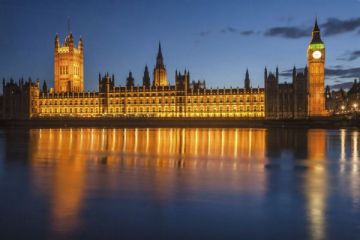by 'The Amateur Historians'
Sarah Valente Kettler & Carole Trimble
If it seems like a medieval enthusiast could spend a week touring churches in London and see little else, well . . . it only seems that way. Had you actually arrived in London as a 12th-century tourist, however, the impression that you'd happened upon a "town of steeples" would have been even more profound.
By 1183 when William Fitz Stephen wrote his Descripto Londonaie, the first contemporary literary portrait of the City, London was home to 13 monastic or conventual (convent) churches and more than 100 parish churches. That translates into one church for every three acres - based on the contemporary population of 30,000 - or, a house of worship for every 300 residents.
Despite a series of devastating fires (particularly the Great Fire of 1666) and the Reformation's ransacking which left most medieval churches in ruins, an impressive group of ancient religious buildings have survived. They provide amateur historians with fascinating insights into the life and times of medieval Christians.
Although some of these surviving churches, such as All Hallows by the Tower, The Temple Church and St Ethledreda's (to say nothing of Westminster Abbey and Southwark Cathedral) are extraordinary and certainly worth your seeking out, we have focused this article on the many churches within the one-square-mile of the City of London. Together, they are easily visited by foot over the course of a day - should the spirit move you. For convenience sake, we have listed the City churches alphabetically.
The opening hours and worship times for the City churches change frequently. The City Churches Development Group publishes a frequently-updated schedule for both touring and worship. It is available in the information section of most churches listed here.
St Andrew Undershaft
St Mary Axe at Leadenhall St, EC3
Aldgate Tube
Note: This church is used for Bible Study only. To visit, request access from the staff at St Helen's Bishopsgate.
Dedicated to the patron saint of Scotland, St Andrew dates back to 1147. Those of us who earn our keep by the pen will be particularly interested in the tomb of John Stow, a tailor by trade, whose detailed account of London in 1598 was, perhaps, the first Amateur Historian's Guide to Medieval & Tudor London.
Keeping Stow company are the remains of the painter Hans Holbein the Younger. Although St Andrew was one of four City churches to survive both the Great Fire and World War II unscathed, our era has not been so kind. Terrorist attacks in the early 90s severely undermined the ancient structure, which has only recently been re-opened for public use.
"Undershaft" means "under the maypole". The name dates from the 15th century. when an annual spring festival was held on the church grounds. This "pagan" custom was banned by dour church fathers after the Evil May Day riots of 1517.
St Bride's
Bride's Lane off Fleet St., EC4
Blackfriar's or Chancery Lane Tube
Note: St Bride's is tucked behind many tall structures. Be patient in your pursuit and feel free to ask for directions.
Disregard, if you will, that the distinctive "wedding-cake" structure is Wren's, and not a tad medieval. The atmosphere of St Bride's is ancient and authentic. Indeed, parts of the crypt are so ancient and authentic, you may well feel the hair on the back of your neck rise! Our Roman, Saxon and Celtic ancestors worshipped on this site as early as the 6th century and tradition holds that St Brides was the first church in London to practice the Christian faith.
Its significance was not lost on the monarch; in 1205, the Curia Regis, the principal court of the country, was held at St Brides. King John held his 1210 parliament here and in 1375, Edward III issued a writ confirming the Charter of the Guild of St Bride. Of course, it's appropriate that this "cathedral of Fleet Street" was the site of the City's first printing press, and that Wynkyn de Worde, the successor to London's first printer, William Caxton, was buried before the high altar.
Although the 15th-century incarnation of Bride's was destroyed in the Great Fire, the ancient crypt has artefacts (and we believe a few poltergeists) from the church's many eras, as well as a small museum dedicated to the publishing business. Check out the £200,000 facsimile of Caxton's Bible - modern, but a sight to behold!
St Dunstan-in-the-West
Fleet St, EC4
Monument Tube
Okay, okay ... so the church is not medieval, or even Tudor. There has been a "St Dunstan's" on this site since 1185. The statue of Elizabeth 1 that graces the exterior dates from 1586, making it not only one of the few contemporary likenesses of Glorianna but also the only outdoor statue of Elizabeth in London. Now, aren't you sorry you complained?
St Giles Cripplegate
Fore St, EC2
Barbican or Moorgate Tube
One of the oldest churches in the City, St Giles was established in 1090 as a lazar house by Henry I's consort "Good Queen Maude" (a.k.a. Matilda, a.k.a. Edith, but that's another story altogether). Evidence of an earlier Saxon-era chapel has been found on the site. The current church was built in 1340, although massive construction in 1545 and post-World War II has left only the ancient tower intact.
Inside, you'll find several important tombs, including those of author John Foxe, naval expert Sir Martin Frobisher, and the poet John Milton. Sir Thomas Moore's parents were married at St Giles, as was the famous Elizabethan actor Edward Allen. Be certain to investigate the noteworthy ruins of the Roman bastion and ancient City Wall that border the churchyard.
Allen built and operated the Fortune Playhouse, just outside St Giles Cripplegate. His bride was the step-daughter of Shakespeare's friendly rival, Phillip Henslowe.
St Helen's Bishopsgate
Great Helen St, EC3
Liverpool Street Tube
The largest surviving ancient church in London, St Helen's boasts a rather interesting design, the result of it once having been two separate houses of worship. The first was a 13th-century parish church, dedicated to the mother of Emperor Constantine. The second was the chapel of a Benedictine convent.
On the convent side of the church is a "squint", which allowed the nuns to observe the parish masses. (This small window on secular life was apparently not enough to sate the good sisters, who eventually had to be admonished to "abstain from kissing secular persons," a habit to which they had become "too prone".)
Among the attractions here are several handsome brasses, including one of a woman in a heraldic mantel. There is also an exemplary collection of memorials: Sir William Pickering, a faithful soldier and scholar under four Tudor monarchs; Sir Thomas Gresham, founder of the Royal Exchange; and Sir John Crosby, merchant and one-time owner of the stunning Crosby Place manor home in Chelsea. Look for the attractive window in memory of parish resident William Shakespeare.
St Katherine Cree
86 Leadenhall St at Creechurch Lane, EC3
Tower Hill or Aldgate Tube
One of eight medieval churches to survive the Great Fire of 1666, St Katherine's was, nevertheless, rebuilt by Inigo Jones in 1628. The original church predated 1280 when it stood on the grounds of Holy Trinity Priory. The only portion of the church that dates from medieval times is the lower portion of the tower - and this, in fact, was originally part of a different building! However, if you are interested in ancient guilds and livery companies, step inside and admire the ceiling.
The striking coats of arms painted there are replicas of those awarded in ancient times to specific trades. The chapel contains the tomb of Sir Nicholas Throckmorton, a key advisor to Elizabeth I. Tradition holds that the elder Holbein was buried under the altar of the preceding church.
St Magnus Martyr
Lower Thames St, EC3
Monument Tube
Throughout the Middle Ages, the St Magnus green was an important gathering place where local citizens congregated, shouting down official heralds as they read royal proclamations or ogling criminals as they bore their public humiliation. The church was closely linked with Old London Bridge - in fact, the approach to the bridge used to pass right through the porch of the church building.
As you enter the gates, you can still see the stones from Old London Bridge, as well as remains from a Roman wharf. A wonderful display of the medieval bridge is on display as soon as you enter the church. The building, alas, is yet another product of Wren's.
We know he is much admired. We know that he was an architectural genius. We know that modern London would not look the same without his graceful touch. However, we also know that Mr Wren was no lover of medieval design and in his efforts to leave his imprint on the City, many of the historic jewels that survived the Great Fire were razed. Sorry, but we do get a tad sour about things like that ...
St Margaret Pattens
Rood Lane, East Cheap, EC3
Monument Tube
Rebuilt by Christopher Wren in 1687, Margaret Pattens still possesses a number of relics from its ancient past. Look for the "1067" inscription on the old stone porch. During the late Middle Ages, pattens - a type of metal-spiked cover which protected footwear from muddy roadways - were manufactured and sold in Rood Lane.
The church is named for this trade and displays a number of pattens in glass cabinets in its entryway. The church's baptismal register is over 450 years old, and there's also a glorious 1543 silver communion cup, the oldest of its type in London.
St Mary le Bow
Bow Lane, Cheapside, EC3
St Paul's or Bank Tube
Note - If all this "food for your soul" has caused you to work up an appetite, succour is on the way! The Place Below Restaurant, located in the crypt of this church, not only serves delicious dishes made from natural ingredients, but is one of the most beautiful and innovative uses we've seen of a medieval crypt. Don't miss it!
Yes, it's another Wren church, but Mary le Bow and the churches that preceded it did play an important role in the history of London in the Middle Ages. The later Plantagenet kings and queens presided over numerous pageants and processions from the stone pavilion outside the church - in fact, Edward III's consort, Queen Philippa, and many others were injured when the grandstand collapsed during the Black Prince's birthday processional. Wren's tower balcony was built to commemorate the 1330 tragedy.
St Mary le Bow's "Bow Bells" have long been famous. They rang nightly curfew for City citizens throughout the Middle Ages and they're also referred to in the legend of Dick Whittington, summoning the young man back to London to assume the task of Mayor. Indeed, it's traditionally asserted that the only true Londoner (or "cockney") is one born within earshot of the Bow Bells. Unfortunately, the original bells did not survive the Great Fire.
St Michael Paternoster
Royal College Hill off Thames St
Cannon Street Tube
One of the City of London's most glorified characters must be Dick Whittington. Four-time Lord Mayor of London, Whittington's true life and personality are hard to separate from myth, despite the awe-inspiring bequests he made to the City upon his death and the plethora of worshipful stories told in his honour. However, we do know that St Michael is very much "Dick Whittington's Church" and the connection is most interesting.
Although the church dates from 1219, Whittington is credited with founding it, for his generous endowments enabled the church to greatly expand in the 1400s. Whittington approached the project as a small "religious village", complete with almshouse and a College of Priests. He established his own residence next door.
This is a fellow who must have lived by the creed, "once is not enough!". Not only was he Lord Mayor of London four times, but he was buried at St Michael's on three separate occasions. Unfortunately, his grave has been missing since the Great Fire, but his memory lives in a beautiful stained glass window on the west wall.
St Olave's Hart Street
Seething Lane and Fenchurch St, EC3
Tower Hill Tube
Originally founded in the 11th century, the current church (third on the site) dates from 1450. Having survived both fire and bombs, this charming church - often described as a "country church in the heart of the City"- has an evocative churchyard and numerous Tudor memorials.
Look for the one dedicated to Elizabeth I, who stood as godmother to Elizabeth Sidney during her 1585 baptism at St Olave's. There is another to Samuel and Elizabeth Pepys. But, perhaps the oddest "person" said to be buried here is Mother Goose. Church documents record her interment on September 14, 1586. A plaque on the outside commemorates the event.
St Sepulchre-without-Newgate (Church of the Holy Sepulchre)
Giltspur St and Holborn Viaduct, EC1
St Paul's Tube
One of the most impressive landmarks in a neighbourhood of important buildings, the 15th-century Church of the Holy Sepulchre has long been linked with the Old Bailey, just opposite. For centuries, a dour churchman would take to the streets outside the church and ring the sorrowful handbell of "inspiration" for prisoners on the eve of execution. In the morning, the tower's tenor bell would toll their execution.
Ancient Ruins
In addition to the previous churches, where one can still tour and attend services, there are numerous ancient religious ruins that you can still glimpse within the City of London.
All Hallows Staining
Mark Lane
All that remains of the 15th-century church is the stone tower, starkly contrasting with its modern neighbours. Don't despair! From the tower, you can enjoy Carole's favourite pastime (not!) and descend into the vaulted 13th-century crypt.
St Alphege, London Wall
London Wall
Not so much a church, but rather an elaborately preserved 14th-century ruin that is often confused, because of its location, with the remains of the Roman wall.
St Ethelburga
Bishopsgate
This is the smallest of the City churches, founded in 1250 and rebuilt in 1390. A mere 51' x 30', this is the perfect example of a medieval parish church, designed to accommodate a family, their household and, perhaps, a handful of neighbours. Extensively damaged by terrorists in 1993, only parts of the church are visible from the street.
By now, you must be feeling like we do: so many churches, so little time! Guess what? There are even more, if you take into account the 15 churches that originated in ancient times and live on in name only. Because these churches have no tangible traces of their medieval and Tudor past, we have omitted them from this compendium - they are, however, detailed in our book, The Amateur Historian's Guide to Medieval & Tudor London, should your curiosity be too great to contain ...
Click on this link to purchase a copy of the Amateur Historian's Guide to Tudor and Medieval London
Sarah Valente Kettler and Carole Trimble are the Amateur Historians. In addition to their recently-published guide to Medieval & Tudor London, the authors have just completed the second book in the Amateur Historians series, Day Trips to the South of London (to be published by Capital Books in January 2002). They are currently researching the medieval and Tudor sites to the north of their favourite city.



